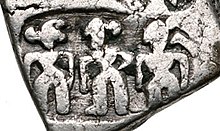Ekanamsha


Ekanamsha ( sanskrit : एकानंशा ; Ekānaṁśā ) est une déesse hindoue . Elle est principalement identifiée au pouvoir illusoire de Vishnu et de Yogamaya[3].
On pense que la déesse était vénérée par les Vrishnis[4]. De nombreuses « triades de parenté », représentant Vasudeva Krishna, Balarama et leur sœur Ekanamsha, ont été trouvées dans la région de Mathura, dont le style est daté des premiers siècles de l'ère commune[5]. On pense qu'elle s'est également réincarnée en déesse Subhadra, fille de Vasudeva et Rohini[6].
Étymologie
[modifier | modifier le code]En sanskrit, Ekanamsha signifie « celui qui est unique et sans portion » et est un nom de la nouvelle lune[7]. Une autre interprétation de son nom est que la déesse Yogamaya est connue sous le nom d'Ekanaṃsha parce qu'elle est née d'une partie ( aṃśa ) de Vishnu lui-même.
Littérature
[modifier | modifier le code]Harivamsa
[modifier | modifier le code]Selon SC Mukherji, dans le Harivamsa, Ekanamsha est identifiée comme une shakti de Vishnu comme la déesse d'Ekadasi, descendue comme la fille de Nanda pour protéger le bébé Krishna de Kamsa[8]. Dans le Harivamsa, elle est représentée comme la sœur de Vishnu, ce qui lui vaut les épithètes Vimala Devi et Yogamaya.
Vishnudharmottara Purana
[modifier | modifier le code]Le Vishnudharmottara Purana décrit la divinité comme Gandhari (le pouvoir d'illusion appartenant à Vishnu), et ce Gandhari représente les divinités Dhrti, Kirti, Pusti, Sraddha, Sarasvati, <i>Gayatri</i> et Kalaratri.
Brahmavaivarta Purana
[modifier | modifier le code]Selon le Brahmavaivarta Purana, Ekanamsha était la fille de Nanda et Yashoda, qui ont été emmenées par Vasudeva. Lorsque Kamsa a tenté de la tuer, elle s'est transformée en déesse Yogamaya, également connue sous l'épithète Durga. Bien que dans d'autres versions, la petite fille soit transportée dans les montagnes Vindhya, dans ce texte, elle reste avec Vasudeva et Devaki. Plus tard, lorsque Krishna épouse sa principale épouse, Rukmini, elle est envoyée avec Durvasa pour le protéger et l'aider[9].
Références
[modifier | modifier le code]- Paul et Paul, « Brahmanical Imagery in the Kuṣāṇa Art of Mathurā: Tradition and Innovations », East and West, vol. 39, nos 1/4, , p. 116–117 (ISSN 0012-8376, JSTOR 29756891)
- (en) Gupta, « Vrishnis in Ancient Literature and Art », Indology's Pulse Arts in Context, Doris Meth Srinivasan Festschrift Volume, Eds. Corinna Wessels Mevissen and Gerd Mevissen with Assistance of Vinay Kumar Gupta, p. 70–72
- (en) www.wisdomlib.org, « Ekanamsha, Ekānaṃśā, Eka-anamsha: 9 definitions », www.wisdomlib.org, (consulté le )
- Bhattacharji, Sukumari (2000).The Indian Theogony: Brahmā, Viṣṇu and Śiva, New Delhi: Penguin, (ISBN 0-14-029570-4), p.173
- Upinder Singh, A History of Ancient and Early Medieval India: From the Stone Age to the 12th Century, Delhi, Pearson Education, , 436–7 p. (ISBN 978-81-317-1677-9)
- (en) Stephen Knapp, The Heart of Hinduism: The Eastern Path to Freedom, Empowerment, and Illumination, iUniverse, , 126 p. (ISBN 978-0-595-35075-9, lire en ligne)
- Hawley, John Stratton and Donna Marie Wolf (1986) (ed.) The Divine Consort: Rādhā and the Goddesses of India, Boston: Beacon Press, (ISBN 0-8070-1303-X), p.372
- Hudson, Dennis (1986) Piņņai, Krishna's Cowherd Wife in John Stratton Hawley and Donna Marie Wolf ed. The Divine Consort: Rādhā and the Goddesses of India, Boston: Beacon Press, (ISBN 0-8070-1303-X), p.256
- Brahmavaivarta Purana Sri-Krishna-Janma Khanda (Fourth Canto) 7th Chapter English translation by Shantilal Nagar Parimal Publications Link: https://archive.org/details/brahma-vaivarta-purana-all-four-kandas-english-translation
Text is available under the CC BY-SA 4.0 license; additional terms may apply.
Images, videos and audio are available under their respective licenses.
